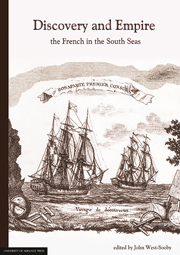Book contents
- Frontmatter
- Contents
- List of Figures
- List of Contributors
- Acknowledgements
- Introduction
- Note on the Second Frank Horner Lecture
- 1 The Globe Encompassed: France and Pacific Convergences in the Age of the Enlightenment
- 2 The Abbé Paulmier's Mémoires and Early French Voyages in Search of Terra Australis
- 3 The Acquisitive Eye? French Observations in the Pacific from Bougainville to Baudin
- 4 Discovering the Savage Senses: French and British Explorers' Encounters with Aboriginal People
- 5 A Case of Peripheral Vision: Early Spanish and French Perceptions of the British Colony at Port Jackson
- 6 New Creatures Made Known: Some Animal Histories of the Baudin Expedition
- 7 “Primitive race”, “pure race”, “brown race”, “every race”: Louis Freycinet's Understanding of Human Difference in Oceania
- 8 Imperial Eyes on the Pacific Prize: French Visions of a Perfect Penal Colony in the South Seas
8 - Imperial Eyes on the Pacific Prize: French Visions of a Perfect Penal Colony in the South Seas
Published online by Cambridge University Press: 05 April 2014
- Frontmatter
- Contents
- List of Figures
- List of Contributors
- Acknowledgements
- Introduction
- Note on the Second Frank Horner Lecture
- 1 The Globe Encompassed: France and Pacific Convergences in the Age of the Enlightenment
- 2 The Abbé Paulmier's Mémoires and Early French Voyages in Search of Terra Australis
- 3 The Acquisitive Eye? French Observations in the Pacific from Bougainville to Baudin
- 4 Discovering the Savage Senses: French and British Explorers' Encounters with Aboriginal People
- 5 A Case of Peripheral Vision: Early Spanish and French Perceptions of the British Colony at Port Jackson
- 6 New Creatures Made Known: Some Animal Histories of the Baudin Expedition
- 7 “Primitive race”, “pure race”, “brown race”, “every race”: Louis Freycinet's Understanding of Human Difference in Oceania
- 8 Imperial Eyes on the Pacific Prize: French Visions of a Perfect Penal Colony in the South Seas
Summary
When European eyes first gazed on the island jewels of the Pacific, there was no way of predicting the role that such territories might play in the future imperial chess game between the British and the French. Ferdinand Magellan's circumnavigation of the globe may have provided naming rights for the largest of the Earth's oceanic divisions, but the peaceful ocean seemed almost entirely empty to him. Apparently deceived by the unfortunate location and lack of water on the tiny atolls of the Disappointment Islands, it was only the western island of Guam that caught his attention on that historic voyage. Subsequent Spanish forays by Mendana de Neira into the South Seas discovered the Gilbert and Ellice Islands, the Solomon Islands and the Marquesas towards the end of the sixteenth century. Some decades later, in 1643, the Dutchman Abel Tasman sighted the Tongan archipelago and Fiji Islands. The prizes of the Pacific were, however, yet to be claimed.
It was the eighteenth century that brought the British and the French into the Pacific, with the discovery of Tahiti by Samuel Wallis in 1767. A year later, Louis-Antoine de Bougainville's arrival launched a torrent of utopian depictions of the island paradise, which was represented as Thomas More's ideal republic and the New Cythera:
To describe correctly what we witnessed, one would need Fénelon's pen, to depict it, Albani's or Boucher's brush. […] Farewell happy and wise people, may you always remain what you are.[…]
- Type
- Chapter
- Information
- Discovery and EmpireThe French in the South Seas, pp. 245 - 282Publisher: The University of Adelaide PressPrint publication year: 2013



